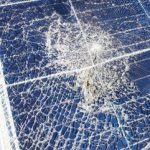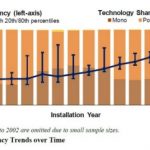Solar PV technology continues to innovate and evolve at a rapid pace. Testing the modules is essential for predicting durability and future performance. But that inevitably means past experience is not a good predictor of the behaviour of the new materials and configurations. Sara Fall and Harrison Dreves at NREL explain how the Durable Module Materials (DuraMAT) Consortium has set up sophisticated testing and data gathering to use the … [Read more...]
Solar PV technology improvements are rapid. But how do you test the long-term reliability of the new designs?
Solar PV module technology moves fast, and is delivering improvements continuously. So fast that it’s no trivial matter to judge the long-term reliability of the changes. It’s a crucial issue as modules, once deployed, are expected to deliver results over lifetimes that span decades. Sara Fall and Jarett Zuboy at NREL describes a process designed to identify and address potential reliability problems quickly, before they are observed in the … [Read more...]
China is still playing the long game with its ‘new three’: solar cells, lithium batteries, EVs
China’s “new three” – or xin san yang – are solar cells, lithium-ion batteries, and EVs. The term harks back to the concept of its “old three” that were once the pillars of its exports: clothing, home appliances and furniture. China’s success is seen in the numbers: it accounts globally for 80%+ of solar cell exports, 50%+ of lithium-ion batteries and 20%+ of EVs. You Xiaoying, writing for China Dialogue, interviews experts and quotes reports … [Read more...]
EU’s 40% domestic Cleantech ambition: same target for Wind (easy) and Solar (hard) doesn’t make sense
The proposed Net Zero Industry Act includes a target for the EU to manufacture domestically at least 40% of its cleantech deployment needs by 2030. That includes the key technologies of solar PV panels, wind turbines (onshore and offshore), EV batteries, heat pumps and hydrogen electrolysers. But it doesn’t make sense to have the same 40% target for all, explain Giovanni Sgaravatti, Simone Tagliapietra and Cecilia Trasi at Bruegel. The main … [Read more...]
Comparing the efficiency and progress of the 5 leading Solar PV cell technologies
NREL’s “Best Research-Cell Efficiency Chart” allows researchers to easily compare the performance of specific PV technologies, stretching back 50 years. It’s regularly updated and is free to use, explains Wayne Hicks and Harrison Dreves at NREL. A new “interactive” version is now available. The focus is on crystalline silicon cells, single-junction gallium arsenide cells, multijunction cells, thin films, and emerging PV. For example, you can … [Read more...]
Solar PV windows on highly glazed skyscrapers can cut energy by 40%+
Around a third of the world’s energy consumption and CO2 emissions come from buildings. Highly glazed skyscrapers and buildings may look beautiful and let in plenty of light, but waste a lot of energy due to the extra cooling needed in summer and heating in winter. Modern skyscrapers can have window-to-wall ratios of 70%+. But modern thermally efficient photovoltaic windows not only provide insulation but turn the absorbed light into power. Wayne … [Read more...]
Latest U.S. modelling shows Battery Storage can support an 80% Renewables grid by 2050
NREL’s latest Storage Futures Study concludes that battery storage should be able to support an 80% renewables grid mix in the U.S. by 2050. Madeline Geocaris at NREL explains how they modelled hundreds of future scenarios to accurately represent the value of diurnal (<12 hours) battery energy storage. The high-storage scenarios made different cost and performance assumptions for storage, wind, solar PV, and natural gas. 15 storage … [Read more...]
What’s best? Building Solar panels that last 30 years, or are short-lived easy-to-recycle and upgrade
The good news is that PV modules last so long – 30 years – that we don’t have to worry about recycling for a while. The bad news is that means we’re not thinking about the alternative pathway of deliberately building modules that last only a few years yet can be easily recycled and improved. Harrison Dreves at NREL describes the data-gathering and creation of a modelling tool that quantifies the flow of materials, energy, and carbon in the PV … [Read more...]
“Floato-voltaics”: floating solar farms on existing municipal water reservoirs
The municipality of Cohoes, population 17,000, in New York State, is building a floating solar farm on its 10-acre water reservoir. It should power all the city-owned buildings and streetlights, save $500,000/year in electricity costs and still leave 40% of the generated electricity remaining for other civic use. It will cost $6m. It will be a first for a U.S. city, explains Connor O'Neil at NREL. The case for city “floato-voltaics” is so … [Read more...]
Using electrostatic repulsion to clean Solar panels, avoiding up to 30% power loss
Dust build-up on solar panels can reduce the power output by as much as 30% in just one month. Even a 1% reduction in power for a 150MW solar installation could result in a $200,000 (€180,000) loss in annual revenue. Cleaning normally requires purified water, but that needs to be trucked in to prime locations like deserts where solar potential is highest. Cleaning with brushes is labour intensive and can damage surfaces irreparably. David … [Read more...]
China should comfortably meet its 2030 Renewables target. But its emissions?
The long Covid lockdown seems to have had little effect on China’s electricity generation growth. In 2021, total generation increased by about 750 TWh (that’s around 1.3 times Germany's absolute total). Solar PV capacity grew by 53 GW last year (equal to the total installed solar capacity in Germany). Half of all offshore wind turbines installed worldwide in 2021 were off the coast of China: the strong additions were accelerated by the January … [Read more...]
Solar “soiling”: energy loss from dust on panels can range from 7% to 50%
Dust and pollution particles on solar cells cut energy conversion, enough to cause big problems for investors let alone those depending on the generation. In parts of the U.S. energy loss can be as high as 7% and 50% in the Middle East. For assets supposed to deliver for 25 to 50 years this is hardly acceptable. Engineering solutions are struggling to keep up with the phenomenal take off of solar. Predicting the effects of “soiling” in your … [Read more...]
A circular economy for waste solar PV materials: what needs to be done to get it started
Solar is already in the vanguard of the energy transition, and can similarly lead the world’s transition to a circular economy. Decommissioned PV modules could total 1 million tons of waste in the U.S. by 2030. Yet there are virtually no incentives or regulations to promote its recycling or reuse. In fact, says NREL, most current regulations in the U.S. define it as solid waste, making it difficult to introduce it to a recycling value chain. In … [Read more...]
Plastic Solar Cells: OPV power conversion efficiency now reaches 18%
Don’t just think plastics are insulators. Two Nobel prizes were won by showing they can be semiconductors. That celebrated research opened the door to polymer-based solar cells. They are made in a lab from common elements, using processes established decades ago for ordinary household items like plastic wrap. A design strategy breakthrough led by NREL has now created an organic photovoltaic (OPV) solar cell with a record-breaking 18.07% power … [Read more...]
Distributed Solar: rooftop residential, commercial systems keep getting cheaper
In the U.S., PV module efficiency (median values) rose from 12.7% in 2002 to 18.4% in 2018, much of it in the last decade and a full percentage-point increase in the last year alone. The best modules are even more efficient, says John Rogers at the Union of Concerned Scientists. Improvements have come from manufacturing processes and cell architectures, and the increasing share of more-efficient mono-crystalline technologies: up from 40% in 2016 … [Read more...]
















